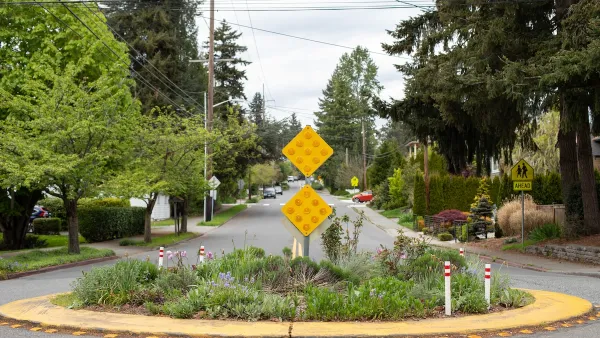A study just published in Economic Development Quarterly documents the geographical destruction on local businesses wrought by a new Walmart store, and raises questions about its long-term impact on sales tax revenues, reports Nate Berg.
The study, authored by a team led by University of Illinois Chicago economics professor Joe Persky, looked at the effect of the opening of a Walmart store on existing businesses and found a direct geographic correlation with rates of closure.
"No matter which direction you go from Walmart, there's a very high rate
of business closures in the immediate vicinity, and the further away
you get there's less and less," says Persky. According to Berg, "Persky and his colleagues found that for every mile closer to the
Walmart, 6 percent more stores closed. Close in around the store's
location, between 35 and 60 percent of stores closed."
"The research also shows that during the study period, from 2006 to 2008,
overall sales tax revenues went down in the two ZIP codes closest to or
encompassing the Walmart," notes Berg.
Granted the study only focused on the effect of one Walmart store, located in the Austin neighborhood of Chicago's West side. It also failed to "include any data on stores that opened during the 2006 to 2008 period, just those that closed."
"Walmart disputes these findings and argues that its stores are magnets for both growth and economic development," says Berg.
FULL STORY: Radiating Death: How Walmart Displaces Nearby Small Businesses

Planetizen Federal Action Tracker
A weekly monitor of how Trump’s orders and actions are impacting planners and planning in America.

Chicago’s Ghost Rails
Just beneath the surface of the modern city lie the remnants of its expansive early 20th-century streetcar system.

Amtrak Cutting Jobs, Funding to High-Speed Rail
The agency plans to cut 10 percent of its workforce and has confirmed it will not fund new high-speed rail projects.

Ohio Forces Data Centers to Prepay for Power
Utilities are calling on states to hold data center operators responsible for new energy demands to prevent leaving consumers on the hook for their bills.

MARTA CEO Steps Down Amid Citizenship Concerns
MARTA’s board announced Thursday that its chief, who is from Canada, is resigning due to questions about his immigration status.

Silicon Valley ‘Bike Superhighway’ Awarded $14M State Grant
A Caltrans grant brings the 10-mile Central Bikeway project connecting Santa Clara and East San Jose closer to fruition.
Urban Design for Planners 1: Software Tools
This six-course series explores essential urban design concepts using open source software and equips planners with the tools they need to participate fully in the urban design process.
Planning for Universal Design
Learn the tools for implementing Universal Design in planning regulations.
Caltrans
City of Fort Worth
Mpact (founded as Rail~Volution)
City of Camden Redevelopment Agency
City of Astoria
City of Portland
City of Laramie




























